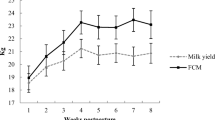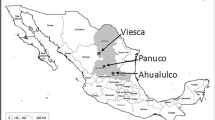Abstract
Changes in milk composition (total solids, carbohydrate, protein, lipid and calculated gross energy content) during lactation in three groups of Tasmanian bettongs (Bettongia gaimardi): free-living animals (wild group), captive animals offered a diet of dry dog food and apples ad libitum (ad lib group), and captive animals fed restricted amounts of the same diet (maintenance group) were related to growth rates (measured as body mass and head length) of their young. There were no significant differences in the concentration of milk solids among the three groups, but the wild group had higher lipid concentrations and the maintenance group had higher carbohydrate but lower protein concentrations. For all three groups, milk total solids increased through lactation from ca. 25% to ca. 45% and carbohydrate concentrations decreased from ca. 18% to about 3%. Protein concentrations increased from ca. 5% to ca. 10% in the wild and ad lib groups, but only from 4% to 8% in the maintenance group. Lipid concentrations increased in the wild and ad lib groups from ca. 4% to ca. 18%, but in the maintenance group only to ca. 7%. Calculated gross energy content of milk increased through lactation in the wild and ad lib groups (from ca. 500 kJ.100 ml−1 to ca. 1,000 kJ.100 ml−1), but there was no significant increase in the maintenance group. The volume of milk produced increased to a peak just prior to permanent pouch vacation by the young, when the gross energy output in milk was 120–150 kJ.3 h−1 in the wild and ad lib groups. On a daily basis this is equivalent to the milk energy output of larger wallabies, and helps to explain the relatively high growth rates of young Tasmanian bettongs. There were significant differences in growth rates among the groups, with the heaviest young always in the ad lib group. Thus differences in milk composition resulting from different planes of nutrition can lead to differences in growth rates of marsupial young.





Similar content being viewed by others
References
Akers RM (2002) Lactation and the mammary gland. Iowa State Press, Iowa
Appleman RD, Gustafson RJ (1985) Source of stray voltage and effect on cow health and performance. J Dairy Sci 68:1554–1567
Bradford MM (1976) A rapid and sensitive method for the quantitation of microgram quantities of protein utilizing the principle of protein-dye binding. Anal Biochem 72:248–254
Claridge AW, Cork SJ (1994) Nutritional value of hypogeal fungal sporocarps for the long-nosed potoroo (Potorous tridactylus) a forest-dwelling mycophagous marsupial. Aust J Zool 42:701–710
Close RL, Bell JN (1990) Age estimation of pouch young of the allied rock-wallaby (Petrogale assimilis) in captivity. Aust Wildl Res 17:359–367
Cowan PE (1989) Changes in milk composition during lactation in the common brushtail possum Trichosurus vulpecula (Marsupialia: Phalangeridae). Reprod Fert Develop 1:325–336
Crowley HM, Woodward DR, Rose RW (1988) Changes in milk composition during lactation in the Potoroo (Potorous tridactylus). Aust J Biol Sci 41:289–296
Delaney R, De'ath G (1990) Age estimation and growth rates of captive and wild pouch young of Petrogale assimilis. Aust Wildl Res 17:491–499
Dove H, Cork SJ (1989a) Lactation in the tammar wallaby (Macropus eugenii) 1. Milk consumption and the algebraic description of the lactation curve. J Zool (Lond) 219:385–397
Dove H, Cork SJ (1989b) Lactation in the tammar wallaby (Macropus eugenii) 11. Intake of milk components and maternal allocation of energy. J Zool (Lond) 219:399–409
Dubois M, Golles KA, Hamilton JK, Rebers PA, Smith F (1956) Colorimetric method for the determination of sugars and related substances. Anal Chem 28:350–356
Ealey EHM (1967) Ecology of the euro Macropus robustus (Gould) in north-western Australia. IV. Age growth. CSIRO Wildl Res 12:67–80
Frappell PB, Rose RW (1986) Function of the gastro-intestinal tract in the potoroo (Potorous tridactylus). Aust J Zool 34:463–71
Green B, Merchant JC, Newgrain K (1987) Milk composition in the eastern quoll Dasyurus viverrinus (Marsupialia: Dasyuridae). Aust J Biol Sci 40:379–387
Green B, Merchant JC, Newgrain K (1988) Milk consumption and energetics of growth in pouch young of the tammar wallaby (Macropus eugenii). Aust J Zool 36:217–227
Green SW, Renfree MB (1982) Changes in the milk proteins during lactation in the tammar wallaby (Macropus eugenii). Aust J Biol Sci 35:145–152
Horwitz WE (1980) Official methods of analysis. Association of Official Analytical Chemists, Washington, USA
Hume ID (1999) Marsupial nutrition. Cambridge University Press, Cambridge
Johnson CN (1994) Nutritional ecology of a mycophagous marsupial in relation to production of hypogeous fungi. Ecology 75:2015–2021
Kinnear JE, Cockson A, Christensen P, Main AR (1979) The nutritional biology of the ruminants and ruminant-like animals—a new approach. Comp Biochem Physiol A 64:357–365
Lucas A, Gibbs JAH, Lyster RLJ, Baum JD (1978) Creamatocrit: simple clinical technique for estimating fat concentration and energy value of human milk. Brit Med J 1:1018–1020
Merchant JC, Sharman GB (1966) Observations on the attachment of marsupial pouch young to the teats and on the rearing of pouch young by foster-mothers of the same or different species. Aust J Zool 14:593–609
Merchant JC, Libke JA, Smith MJ (1994) Lactation and energetics of growth in the brush-tailed bettong Bettongia penicillata (Marsupialia: Potoroidae) in captivity. Aust J Zool 42:267–277
Messer M, Green B (1979) Milk carbohydrates of marsupials II. Quantitative and qualitative changes in milk carbohydrates during lactation in the tammar wallaby (Macropus eugenii). Aust J Biol Sci 32:519–531
Munks SA (1990) Ecological energetics and reproduction in the common ringtail possum Pseudocheirus peregrinus (Marsupialia: Phalangeroidae). PhD Thesis, University of Tasmania
Prentice AM, Whitehead RG (1987) The energetics of human reproduction. In: Loudon ASI, Racey PA (eds) Reproductive energetics in mammals Symp Zool Soc Lond 57:275–304
Rose RW (1985) The reproductive biology of the Tasmanian bettong Bettongia gaimardi. PhD thesis, University of Tasmania
Rose RW (1986) The control of pouch vacation in the Tasmanian bettong (Bettongia gaimardi). Aust J Zool 34:485–491
Rose RW (1987) Reproductive energetics of two Tasmanian rat-kangaroos (Potoroinae: Marsupialia). Symp Zool Soc Lond 57 149–165
Rose RW (1988) Age estimation of the Tasmanian bettong (Bettongia gaimardi) (Macropodoidae: Marsupialia). Aust Wildl Res 16:251 261
Rose RW (1989) Comparative growth rates in the Macropodoidea. In: Grigg G, Jarman P, Hume I (eds) Kangaroos, wallabies and rat kangaroos. Surrey Beatty, Sydney
Rose RW (1997) The metabolic rate of a mycophagous marsupial: Bettongia gaimardi. www Journal of Biology 2 http://epresscom/w3jbio/rose/rosehtm
Sadleir RHFS (1969) The ecology of reproduction in wild and domestic mammals. Methuen, London
SAS (1989) SAS Institute SAS/STAT User's Guide, Version 6, 4th edn. Vol. 2, Cary, N.C.
Serena M, Soderquist TR (1988) Growth and development of pouch young of wild and captive Dasyurus geoffroii (Marsupialia: Dasyuridae). Aust J Zool 36:533–543
Sharman GB, Frith HJ, Calaby JH (1964) Growth of the pouch young tooth eruption and age determination in the red kangaroo Megaleia rufa. CSIRO Wildl Res 9:20–49
Shield JW, Woolley P (1961) Age estimation by measurement of pouch young of the quokka (Setonix brachyurus). J Physiol Lond 9:14–23
Smith M (1989) Release of embryonic diapause in the brush-tailed bettong Bettongia penicllata In: Grigg G, Jarman P, Hume I (eds) Kangaroos, wallabies and rat kangaroos. Surrey Beatty, Sydney
Smolenski AJ, Rose RW (1988) Comparative lactation in two species of rat-kangaroo (Marsupialia) Comp Biochem Physiol A 90:459–464
Taylor RJ (1990) Population structure and condition of Bettongia gaimardi in Tasmania. Aust Zool 26:23–25
Taylor RJ, Rose RW (1987) Comparison of growth of pouch young of the Tasmanian bettong Bettongia gaimardi in captivity and in the wild. Aust Wildl Res 14:257–262
Tyndale-Biscoe CH, Renfree MB (1987) Reproductive physiology of marsupials. Cambridge University Press, Cambridge
Verkerk GA, Fisher AD, Morrow CJ, Matthews LR (1999) The effects of stressors on milk yield and composition in dairy cows. Proc NZ Soc Anim Prod 59:192–194
Wallis IR, Farrell DJ (1992) Energy metabolism in potoroine marsupials. J Comp Physiol B 162:478–487
Wallis IR, Hume ID (1992) Maintenance nitrogen requirements of potoroine marsupials. Physiol Zool 65:1246–1270
Wallis IR, Green B, Newgrain K (1997) Seasonal field energetics and water fluxes of the long-nosed potoroo (Potorous tridactylus) in southern Victoria. Aust J Zool 45:1–11
Wood JT, Poole WE, Carpenter SM (1983) Validation of aging keys for eastern grey kangaroos Macropus giganteus. Aust Wildl Res 10:213–217
Acknowledgements
The authors wish to thank B. Gartrell and E. Wronski for their help in caring for the animals. We thank C.N. Johnson for his assistance with some of the trapping of bettongs in the wild and O. Buchman for his comments on the manuscript.
Author information
Authors and Affiliations
Corresponding author
Additional information
Communicated by I.D. Hume
Rights and permissions
About this article
Cite this article
Rose, R.W., Morahan, T.M., Mulchay, J.E. et al. Milk composition and growth in wild and captive Tasmanian bettongs, Bettongia gaimardi (Marsupialia). J Comp Physiol B 173, 125–133 (2003). https://doi.org/10.1007/s00360-002-0315-7
Accepted:
Published:
Issue Date:
DOI: https://doi.org/10.1007/s00360-002-0315-7




